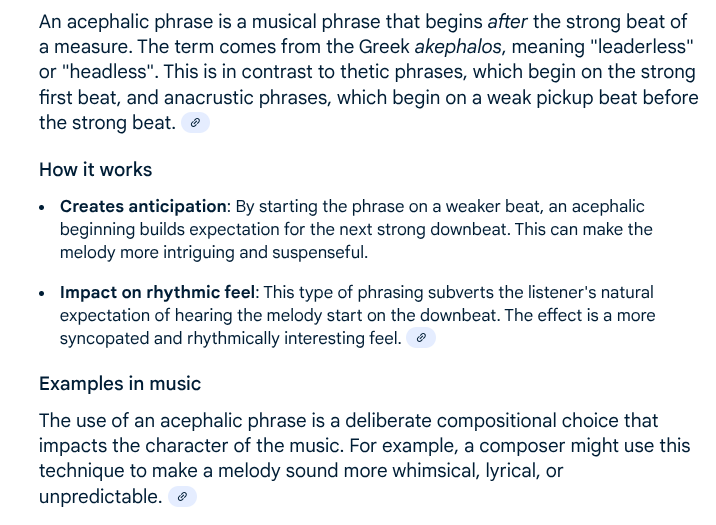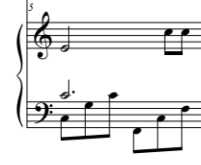All Activity
- Past hour
-

Oboe Concerto
GospelPiano12 replied to GospelPiano12's topic in Incomplete Works; Writer's Block and Suggestions
Ahhh ok, so leave it and have it stay as 14 I'll need to do some research on concerto structure and what is technically challenging for the obo so that I don't make this too easy to play or boring -
The piece that got me back into writing music, this past December...
-
.thumb.png.8b5b433a341551e913a34392660bc95b.png)
Oboe Concerto
PeterthePapercomPoser replied to GospelPiano12's topic in Incomplete Works; Writer's Block and Suggestions
Yeah - a pick-up and an anacrusis are just different names for the same thing. If you made that first F an anacrusis then your phrase would be 13 measures long though. -

Oboe Concerto
GospelPiano12 replied to GospelPiano12's topic in Incomplete Works; Writer's Block and Suggestions
Oh okay, now I understand - brain fart moment lol The F is the beginning of the melodic material, but since I have two empty beats before that, I can fill up that space. Couldn't I also just get rid of the rests and make that measure an anacrusis? --> was thinking of having some strings and F. Horn play a countermelody + harmony as the theme comes in. I've never even attempted writing a counter melody before, so that should be fun. - Today
-
.thumb.png.8b5b433a341551e913a34392660bc95b.png)
Oboe Concerto
PeterthePapercomPoser replied to GospelPiano12's topic in Incomplete Works; Writer's Block and Suggestions
The phrase starts before the melody comes in so the beginning of the phrase is just the beginning of your first bar rather than starting the phrase on bar 2 as if the F in bar 1 was a pick-up. So the phrase might start with some kind of accompanimental pattern with the first two beats being a space in which melodically nothing happens (until the F comes in). -

Oboe Concerto
GospelPiano12 replied to GospelPiano12's topic in Incomplete Works; Writer's Block and Suggestions
Hmmm, so how do I treat it as an "acephalic" vs a regular/other phrase type @PeterthePapercomPoser? Just wanting some more clarification -
Churchcantor started following Impromptu no.1, Op.5 - Sibelius - Guitar Arrangement
-
Impromptu no.1, Op.5 - Sibelius - Guitar Arrangement
Churchcantor replied to Thatguy v2.0's topic in Chamber Music
Cool! Someone else likes to compose/arrange guitar music! -
BachGirl joined the community
-
.thumb.png.8b5b433a341551e913a34392660bc95b.png)
Oboe Concerto
PeterthePapercomPoser replied to GospelPiano12's topic in Incomplete Works; Writer's Block and Suggestions
It's neither good nor bad - or at least it depends on what you want to do with it. It's just a characteristic. -
You're the composer, so only you can make that decision. Certainly it can be more virtuosic than what you have! I mean I at least assume that the bassoonist can play some scales in an easy enough key. You can still fit a lot of music into 5 minutes if the tempo is fast enough. Check out this winning Bassoon Concerto that a member here submitted for a competition in the summer of 2020 when I first signed up for YC!
-
Three Part Songs to Poems by G.M. Hopkins
Churchcantor replied to Churchcantor's topic in Choral, Vocal
I'll get the second one in pretty soon. I am a bit drunk on beer right now, and can technically compose or enter notes when drunk, but functionally cannot enter notes when drunk! Go figure... Anyone interested: I actually remembered to put in composition dates on these three partsongs! They are of course partsongs, so the alto and tenor voices are not so interesting. The Windhover, 4-29-21. Binsey Poplars 3-20-21, Spring 5-02-21. You will have to wait for the second two: TOO MUCH BEER! 😋 -
Hello dear fellow composers. This poem (1886) is part of Laforgue’s Imitation of Our Lady the Moon. Here the Moon is no longer a muse or confidante, but becomes the star of farewell and forgetting, sealing human hopes in silence and nothingness. I truly believe that this cycle reflects a part of Laforgue’s own biography — that of a young poet caught in an impossible, broken love story, one almost erased from history, save perhaps for the initial of a name glimpsed in his correspondence. At least, that is the conviction I had while reading these poems. And so here is the end of my cycle: a piece deliberately sparse, rarefied, silent. It is also, perhaps, a farewell to Laforgue — for now. Time has come for me to explore new paths (and I have been kindly reminded more than once that I am probably composing with a delay of about 120 years…). I can only hope that these pieces may nevertheless have found some resonance with you. This is one of my most sincere works, born from a curious overlapping of states of mind with Laforgue. And I believe — to confess under the cover of anonymity — that one is never truly safe from falling secretly in love, even at my age. Perhaps this is what makes the kinship so troubling.
-
- 1
-

-
This piece is clever, yet awful. It would make for very good horror movie music. BTW, Outis is ancient Greek for "Nobody!"
-

Oboe Concerto
GospelPiano12 replied to GospelPiano12's topic in Incomplete Works; Writer's Block and Suggestions
-
Many thanks for your review Peter. Do you think this can be salvaged; or should just rip it up and start again? I can't make it too virtuosic, as I'm writing for an amateur bassoonist. I had a choice of instruments, and decided bassoon would be the most challenging. Since it's a quiet instrument, it doesn't come through very strongly against the orchestra. Plus it's in the bass register: so maybe not a natural instrument to carry the melody. I was trying to create a dialogue between the bassoon and orchestra, using call and response. Guess I haven't done a very good job though. The 5-minute time limit is also a challenge, since it doesn't give much opportunity for development.
-
6 Valses : my composition
Vasilis Michael replied to Vasilis Michael's topic in Piano Music, Solo Keyboard
Thank you so much for your wonderful words and your appreciation of my music. Yes, I consider myself a composer mainly for the piano, although I truly love orchestral music, and especially chamber music. Chamber music is my favorite... I just don’t feel familiar enough with the other instruments, although I have written a divertimento for winds and two minuets for string quartet. For a first attempt, it was quite a respectable effort, and I would definitely like to continue and write music for more instruments—it’s just that, at this point in my life, I don’t have enough free time to achieve that. I have also played Chopin’s mazurkas and polonaises in my repertoire, but I haven’t yet happened to compose something similar, although I would very much like to, and I thank you for pointing it out. -
Henry Ng Tsz Kiu started following Orchestration of Dvorak's Five Bagatelles
-
Thanks Peter. Was this a suite you'd not heard before? Will definitely try your suggestion with the strings. Think slurs would probably help too. The flute renditions are the most problematic for me. I don't like the sound where two virtual flutes are playing the same line. I did this because the melodies were sometimes being drowned out by the rest of the orchestra. Think I might resolve the problem by using a single flute track with the fader pushed up, rather than having two flutes.
-
.thumb.png.8b5b433a341551e913a34392660bc95b.png)
Oboe Concerto
PeterthePapercomPoser replied to GospelPiano12's topic in Incomplete Works; Writer's Block and Suggestions
I think what with the way you changed the melody it now makes more sense to treat the melody as if it was an acephalic phrase. Counting the first measure as the beginning of the phrase, instead of just a pick-up note makes your phrases 14 measures long, with clear markers separating it out into 2 measure fragments (mostly). I think it makes more sense to look at it that way rather than as if the first F was a pick-up note. -
Hey Mark @MJFOBOE! I love this song! I love the words, key changes and counterpoint between the various different voices of the choir! It'll probably be a lot of fun to sing for any future choir that might undertake a performance! Great job! The only thing that bothers me is a little nit-pick about how you notated the following rhythm: The right hand of the piano should be a dotted quarter note tied to an 8th of the following compound beat (beat 4 in 12/8), to group the 8th notes properly in their groups of three. Thanks for sharing and once again, bravo! (I liked the original song too but I think this one is even better)
-
.thumb.png.8b5b433a341551e913a34392660bc95b.png)
unnamed VGM
PeterthePapercomPoser replied to therealAJGS's topic in Incidental Music and Soundtracks
Hey @therealAJGS! I like the Locrian inflection in this bass line you've come up with! I think the tambourine works but the drum kit is far from how an actual drummer would play. Improving your drumming patterns could really help this instrumental. Check out this video if you haven't already: Also another thing - I used to participate in an online monthly music contest website called midi-contest.com. It's now defunct and doesn't exist, but the owner of the site put a minimum duration limit on all submissions to the contest - 1 minute 30 seconds. As far as he was concerned everything under that duration was total trash! LoL From then on I've always tried to make my pieces at least that long haha. Thanks for sharing! -
Hi @Alex Weidmann! I know it's hard working with the Musesounds sometimes in getting it to perform good articulations especially with the strings. But, could you have maybe made the 2nd Bagatelle a bit more clearly articulated by using staccato marks on the 16th notes and accents on the dotted 8ths or something? It's really unclear in this rendering. I see you tried using staccati at meas. 234 but you articulated the 3rd note in the triplets where for me it would make more sense to staccato the 2nd one since the repeated G comes right after that. Those are just some things I wanted to pick on LoL. But overall I really enjoyed these bagatelles! I really love your choice of repertoire that you're orchestrating! Great job and thanks for sharing!
-
.thumb.png.8b5b433a341551e913a34392660bc95b.png)
6 Valses : my composition
PeterthePapercomPoser replied to Vasilis Michael's topic in Piano Music, Solo Keyboard
Hi again @Vasilis Michael! I love this little set of waltzes! And I like how you composed them to be played one after another. They're both Chopinesque and perhaps Schubertian or Schumannesque too. I love the chromaticism! No. 5 is perhaps my favorite of the bunch with it's chromatically descending harmonies. I wonder if you've ever tried your hand at a polonaise or mazurka? But also, from what I've seen of your YouTube channel you consider yourself, like Chopin, a composer primarily for the piano. Maybe you could explore composing some chamber works or even works for orchestra? Thanks for sharing these gems! -
Hey @Alex Weidmann! To me the Bassoon is far from center stage nor juxtaposed as a soloist against the orchestra. Usually the title of "concerto" implies some virtuosity from the soloist but there doesn't seem to be any here. Also, the bassoon is not given any kind of definitive thematic material that would give it the spotlight. Usually concerti have double expositions of the thematic material to allow the orchestra and soloist to be juxtaposed against each other with the character of the main theme. It doesn't have to be like that of course as sometimes the soloist and orchestra start together like in a concertante. And whether the soloist or the orchestra starts first is also up for debate. But from what I hear so far there doesn't seem to be any thematic material that has potential for this kind of treatment in this piece. Perhaps you could make this into the slow movement of a concerto, but the main introduction and finale of the concerto would be expected to be more athletic, catchy and to have a antagonistic relationship between the soloist and the orchestra with a recognizable theme driving that antagonism. That's my take on that. Thanks for sharing!
-
Hi @Fugax Contrapunctus! I like how you reinterpret the subject of the canon in the choir to allow you to fit in more syllables - that worked out quite well! And the whole canon has a nice structure that is corroborated by the orchestration where every time the canon repeats (returns back to its original key) a new group of instruments (woodwinds) or choir is added to bring the repetition into more of a high relief. It's a joy to listen to! Also - did you mean the Oboe 2 part to be played by English Horn? It seems to be too low for Oboe. And a very nice rounded off ending. Thanks for sharing!
-
.thumb.png.8b5b433a341551e913a34392660bc95b.png)
Experimental piano duet
PeterthePapercomPoser replied to Alant's topic in Incomplete Works; Writer's Block and Suggestions
Hello @Alant! Very interesting and weird piano experiment! It's weird enough harmonically to maybe warrant posting a PDF score if you have one? I think it could easily be lengthened and/or arranged for different instruments which would make it even more interesting. Thanks for sharing!





